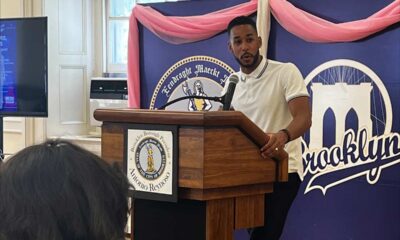Community News
Future Envisioned, Plans Activated at BK NAACP

Last month’s Brooklyn NAACP General Membership meeting, held at Bedford Stuyvesant Restoration Corporation, closed the year with an eye on the future in many ways. Branch President L. Joy Williams’ program included a look at Brooklyn Borough President Antonio Reynoso’s dynamic view of the future for the borough and offered a glimpse of pre-teens, all organizational members, who will soon be at the forefront of activating Ms. Williams’, the branch’s and BP Reynoso’s respective good works and shared missions.
The meeting was held on Wednesday, November 29, 2023, a month out from the branch’s 100th anniversary celebration. The meeting opened with the Youth Council presenting its recruitment and outreach goals for its 2024 January opening meeting.
The General Membership Meeting agenda provided branch reports and updates on the branch’s Black Brooklyn Agenda accompanied by reports on the Reparations Commission Legislation (please note Ms. Williams’ appeal on this page); and the Prospect Park Alliance’s “reimagining” efforts for the Lefferts House.
The presence of Brooklyn Borough President Antonio Reynoso at the meeting to explain his Comprehensive Plan for Brooklyn was also a highlight, and it was also impressive that he valued the organization to give it such precious time.
As a former active member of the NAACP Youth Council, this writer was personally impressed by the role young people – preteens — played in facilitating the meeting and convening their own meeting.
Like all grassroots organizations concerned with systemic change, the Brooklyn Branch of the NAACP recognizes the necessity of training youth to be the next generation of capable movement workers. L. Joy Williams, branch president, said that the organization must invest in “giving the children agency” as well as “helping them explore their ability as organizers.”
This sentiment was on full display that night. The youth council, that night, was attended by four young girls, included Tamaya, 11, and Terry, 8. They were completely invested in their youth project, which Ms. Williams designed with them as a way to engage them and attract more youth to become involved in the NAACP nonprofit.
The girls’ chaperoning elders encouraged the preteens to take control of their voice, and their project. They inquired about the budget (after suggesting the hiring of a florist “so the place would look nice”. Their involvement reveals how the branch’s objective to enlighten the young people about their power has come alive. NAACP-BK is making things happen.
Also, at the branch meeting, another subject covered was the 2024 NY Priority Voter Drive, a multi-year initiative launched by the Branch to “raise the next generation of priority voters in New York.”
Ms. Williams also offered updates on important joint initiatives that the Branch was undertaking, including the aforementioned action around reparations and partnership with the Prospect Park Alliance’s “ReImagine Lefferts Initiative” — a re-envisioning of the Lefferts Historic House museum, exploring the lives, resistance, and resilience of the Lenape people, whose unceded ancestral lands the park and house rests upon, and also acknowledging the Africans enslaved by the Lefferts family.
Ms. Williams presented an update on the NYS Senate Bill S1163A, which establishes a commission to study reparations in New York State. She also shared the intention of the branch to lobby for further reparations legislation, including introducing a bill to allow African Americans to take a free ancestry test at any New York City public library.
Brooklyn Borough President Antonio Reynoso took the floor to give a summary of his 200-page “Comprehensive Plan for Brooklyn: A Vision for a Healthier, More Equitable Borough,” which details the administration’s “vision for equitable growth based on a comprehensive analysis of conditions across the borough.”
In his 15-minute summary, he spoke of the need for planning, saying that “we are too poor not to plan” and that “all the ills in society are rooted in bad planning.”
Within the Plan, Reynoso cites reasons for “the decades of neglect and divestment” experienced by certain neighborhoods and points to the horrific disparities in health and wellness that inspired his report and fuels his tireless work as a visionary leader. – Nehemi’EL Simms













